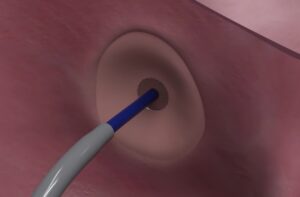
First-in-human results of a novel transseptal puncture device from Protaryx Medical were presented at the 2025 Society of Thoracic Surgeons (STS) annual meeting (25–27 January, Los Angeles, USA).
The device is a novel catheter system designed to improve the safety, accuracy and ease of transseptal puncture to facilitate access to the left atrium for procedures such as left atrial appendage closure (LAAC), transcatheter mitral valve procedures, and atrial fibrillation (AF) ablation. The device features an atraumatic, echogenic retractable nitinol mesh, as well as an extendable distal catheter, which are intended to enhance imaging visibility and aid deployment.
Results of the first-in-human study, which included five cases conducted on 3 December 2024 at Sanatorio Italiano de Asunción (Asunción, Paraguay) under approval from the Research Ethics Committee of the Paraguayan Institute of Social Studies, were presented at STS 2025 by Rachael Quinn (Johns Hopkins Health System, Baltimore, USA).
“We spent a lot of time analysing clinical needs. The result is a device designed to simplify workflow, enhance precision, and provide excellent echocardiographic visibility. Our goal was not just to develop another transseptal system, but to rethink the approach—ensuring greater predictability and ease of use for physicians while prioritizing patient safety. We’re excited to provide a solution that truly aligns with what clinicians have been asking for.” Quinn told Cardiovascular News. “A major finding from our research was that poor device visibility under echocardiography was a key factor contributing to procedural challenges, safety concerns, workflow inefficiencies, and increased radiation exposure. With the Protaryx device, we’ve changed that. Our system is highly visible under echo, making transseptal puncture a simpler and faster procedure.”
Patients enrolled in the study averaged 46 years old (23–60 years), and four were female. In all, five transseptal puncture procedures were conducted to facilitate the delivery of essential left heart therapies. Two of the cases involved balloon mitral valvuloplasty were guided by transoesophageal echocardiography (TEE) and three were patent foramen ovale (PFO) closures guided by intracardiac echocardiography (ICE). The Protaryx device was highly visible under both echocardiographic modalities.
All transseptal punctures were successful at the targeted locations without adverse events, Quinn reported, and median transseptal puncture time, defined as the time elapsed between placement of the guidewire in the femoral vein to removal of the wire and dilator from the left atrium, was 10 minutes. Median fluoroscopy time during transseptal puncture was nine seconds. TSP time was favorable compared to previously reported values within the literature, and fluoro time was ten-fold less than those previously reported. The device catheter and distal extendable end-effector were very visible on both ultrasound modalities, allowing the operating physician to precisely pick the crossing point applicable to the subsequent therapeutic device.
None of the patients required more than one transseptal puncture attempt, and there were no incidences of perioperative or postoperative mortality, stroke, renal failure, AF, cardiac tamponade, or pericardial effusion. All patients were discharged within 12 hours in good condition.
Protaryx Medical anticipates a 501(k) submission to the US Food and Drug Administration (FDA) for the device in late 2025.
“There are more than half a million transseptal punctures done every year in the USA, and we believe that this will slash the learning curve and facilitate surgeons’ involvement in left heart catheter-based procedures,” James Gammie, Protaryx co-founder and system chief of cardiac surgery at Johns Hopkins Health System, tells Cardiovascular News. “We think it will make it safer for patients and it will enable operators to precisely pick where they cross the fossa.”










